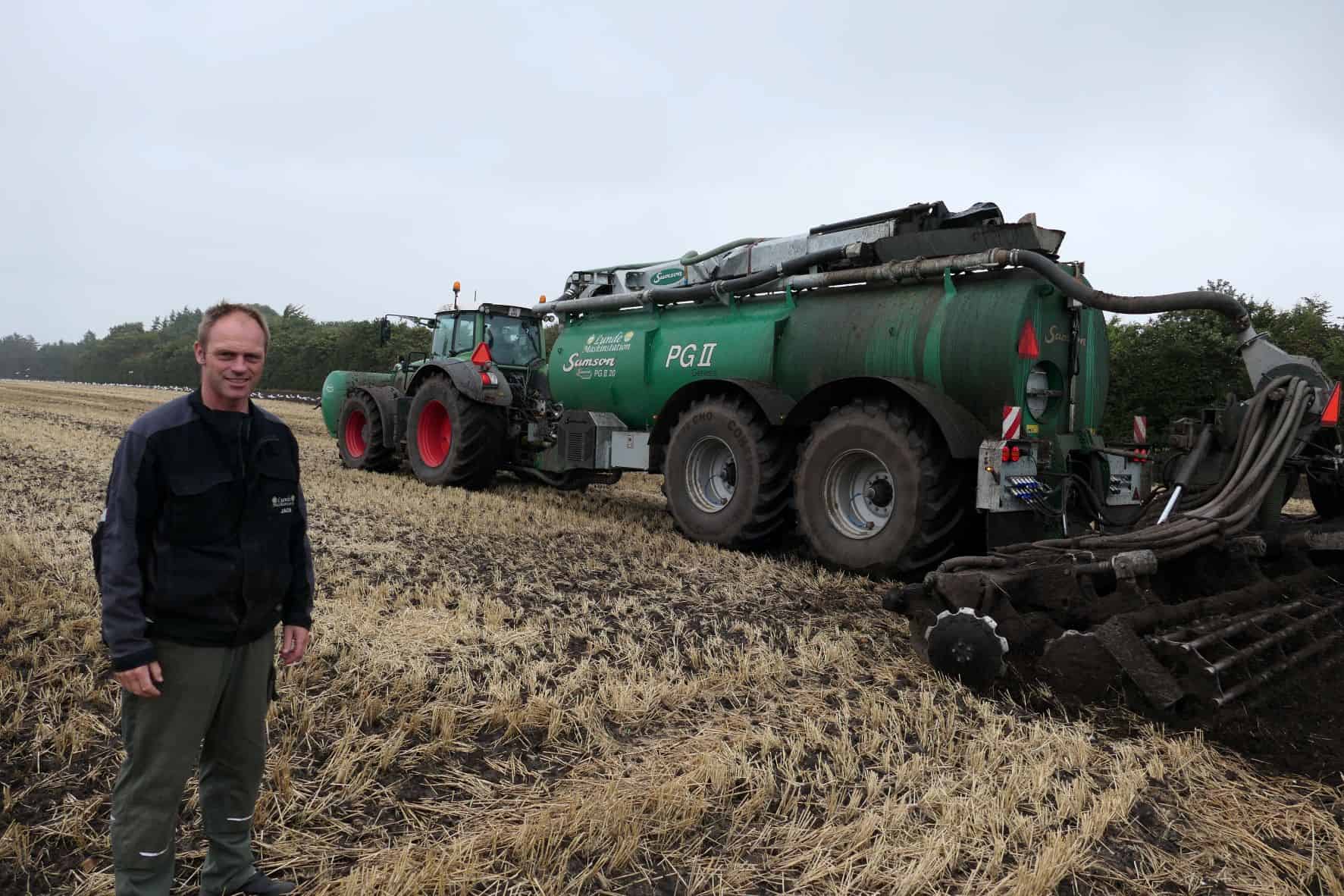
- Jacob Ravn, Lunde Maskinstation, can now offer slurry deposition with a two-axle 20-ton truck with large low-pressure wheels and front tank with a larger hourly capacity than before. This requires rethinking the transportation chain from tank to trap. (Photo: Bøje Østerlund. Bottom of the page)
In some situations, Jacob Ravn, owner of Lunde Maskinstation near Varde, has achieved increased application capacity by downsizing to a smaller slurry tanker.
- It may seem strange to invest in a SAMSON PG II 20 when the two other trucks in the machine station are larger, a SAMSON PG 25 and SAMSON PG II 31 respectively. But it's part of a strategic shift towards less ground pressure and less mess on the road. Both the farmers and I have an interest in improving our image during the slurry season.
- And it works with the new SAMSON PG II 20 Genesis because it only stays in the field and the slurry is now transported from the tank to the field with a buffer truck. We are accepted by other road users.
The adaptation and use of the buffer wagons together with the new SAMSON Genesis wagon has meant that Jacob Ravn has had to rethink manure spreading.
- Firstly, we can now keep the SAMSON Genesis trailer in the field at all times. It has extra large wheels and VF tires that run on low air pressure, which protects the ground. Next, I bought two used SAMSON PG 25 slurry trailers that serve as buffer trailers.
While the tractor driver is at home after another load with the second slurry tanker, the slurry is transferred from the filled buffer tank to the new SAMSON PG II 20 Genesis in the field.
This is done with the future-proof SAMSON Ejector suction system. (Photo: Lunde Maskinstation. Bottom of the page)
- When the Genesis trailer and the three-ton front tank of the tractor with the down feller buncher are emptied, the tractor driver with the full buffer trailer has arrived and placed it in a suitable location in the field. He now disconnects the full cart and connects to the empty buffer cart and drives home after the next load. Of course, all this is only possible with the Siwi Combi Hitch system on the tractor and the two SAMSON buffer trailers, explains Jacob Ravn.
The ground pressure and crop-friendly slurry spreading that Lunde Maskinstation currently practices requires slightly more investment. A Siwi Combi Hitch system and transport from tank to field with a buffer truck. I expect such a buffer truck to last for many years, says Jacob Ravn about the used SAMSON PG 25. (Photo: Bøje Østerlund. Bottom of page)
Jacob Ravn has chosen to continue to have a pump tower on his buffer trucks for filling at home by the slurry tank to avoid having to go out and move a tractor pump every time a new tank needs to be moved.
When pumping the slurry from the buffer wagon in the field, Jacob Ravn uses the Genesis wagon's SAMSON Ejector system, which is a suction and pumping system that moves the slurry into the wagon.
- It's a closed system that doesn't make a mess or smell much. And then we avoid having to reload the slurry in the same place every time," Jacob Ravn points out.
With truck transport and a large fixed buffer tank, we quickly create a muddy area in the field and of course more driving in the field because we can't move a large fixed buffer tank all the time.
- With the SAMSON Ejector suction system, the contractor's Genesis truck can also pump slurry from a truck from the biogas plant that has the same connection system.
As one of the first with the combination of buffer wagons, Siwi Combi Hitch and a SAMSON PG II 20 Genesis slurry tanker for delivery, Jacob Ravn has - after delivering 55,000 tons of slurry so far this year - analyzed and calculated the capacities.
- For example, with a distance of 1.5 to 2.0 kilometers to the tank, when we apply 50 tons of slurry per hectare for corn this spring, one man in the field with the Genesis truck and one man and tractor for the two trucks can maintain a capacity of 140 to 150 tons per hour. For shorter distances of less than half a kilometer, however, it is not worth using the buffer wagons, just as long distances are obviously not suitable for tractor transport of slurry.
- But overall in our area with many larger cattle farms, we have definitely been able to increase slurry spreading capacity. And at the same time created a better image for the farmers towards the surrounding community and the many tourists who drive on the roads around here, concludes Jacob Ravn.
According to Jacob Ravn, the advantage of using buffer trucks and keeping the delivery vehicle on the field all the time is greatest when there are high allocations.
- This results in a lower load on the ground when spreading and felling is done with a two-axle trailer with the large 194 cm high low-pressure tires.
Monday – Thursday:
07.00 – 16.00
Friday
07.00 – 15.00
Petersmindevej 6, DK-8800 Viborg
VAT no. 10963230

Copyright © 2024 Samson Agrolize